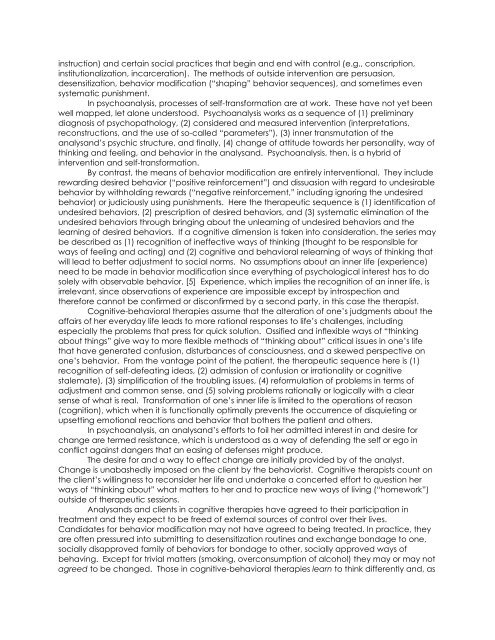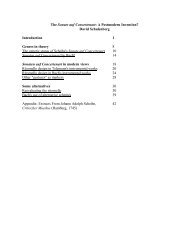SEVEN PAPERS ON EXISTENTIAL ANALYSIS ... - Wagner College
SEVEN PAPERS ON EXISTENTIAL ANALYSIS ... - Wagner College
SEVEN PAPERS ON EXISTENTIAL ANALYSIS ... - Wagner College
You also want an ePaper? Increase the reach of your titles
YUMPU automatically turns print PDFs into web optimized ePapers that Google loves.
instruction) and certain social practices that begin and end with control (e.g., conscription,<br />
institutionalization, incarceration). The methods of outside intervention are persuasion,<br />
desensitization, behavior modification (“shaping” behavior sequences), and sometimes even<br />
systematic punishment.<br />
In psychoanalysis, processes of self-transformation are at work. These have not yet been<br />
well mapped, let alone understood. Psychoanalysis works as a sequence of (1) preliminary<br />
diagnosis of psychopathology, (2) considered and measured intervention (interpretations,<br />
reconstructions, and the use of so-called “parameters”), (3) inner transmutation of the<br />
analysand’s psychic structure, and finally, (4) change of attitude towards her personality, way of<br />
thinking and feeling, and behavior in the analysand. Psychoanalysis, then, is a hybrid of<br />
intervention and self-transformation.<br />
By contrast, the means of behavior modification are entirely interventional. They include<br />
rewarding desired behavior (“positive reinforcement”) and dissuasion with regard to undesirable<br />
behavior by withholding rewards (“negative reinforcement,” including ignoring the undesired<br />
behavior) or judiciously using punishments. Here the therapeutic sequence is (1) identification of<br />
undesired behaviors, (2) prescription of desired behaviors, and (3) systematic elimination of the<br />
undesired behaviors through bringing about the unlearning of undesired behaviors and the<br />
learning of desired behaviors. If a cognitive dimension is taken into consideration. the series may<br />
be described as (1) recognition of ineffective ways of thinking (thought to be responsible for<br />
ways of feeling and acting) and (2) cognitive and behavioral relearning of ways of thinking that<br />
will lead to better adjustment to social norms. No assumptions about an inner life (experience)<br />
need to be made in behavior modification since everything of psychological interest has to do<br />
solely with observable behavior. [5] Experience, which implies the recognition of an inner life, is<br />
irrelevant, since observations of experience are impossible except by introspection and<br />
therefore cannot be confirmed or disconfirmed by a second party, in this case the therapist.<br />
Cognitive-behavioral therapies assume that the alteration of one’s judgments about the<br />
affairs of her everyday life leads to more rational responses to life’s challenges, including<br />
especially the problems that press for quick solution. Ossified and inflexible ways of “thinking<br />
about things” give way to more flexible methods of “thinking about” critical issues in one’s life<br />
that have generated confusion, disturbances of consciousness, and a skewed perspective on<br />
one’s behavior. From the vantage point of the patient, the therapeutic sequence here is (1)<br />
recognition of self-defeating ideas, (2) admission of confusion or irrationality or cognitive<br />
stalemate), (3) simplification of the troubling issues, (4) reformulation of problems in terms of<br />
adjustment and common sense, and (5) solving problems rationally or logically with a clear<br />
sense of what is real. Transformation of one’s inner life is limited to the operations of reason<br />
(cognition), which when it is functionally optimally prevents the occurrence of disquieting or<br />
upsetting emotional reactions and behavior that bothers the patient and others.<br />
In psychoanalysis, an analysand’s efforts to foil her admitted interest in and desire for<br />
change are termed resistance, which is understood as a way of defending the self or ego in<br />
conflict against dangers that an easing of defenses might produce.<br />
The desire for and a way to effect change are initially provided by of the analyst.<br />
Change is unabashedly imposed on the client by the behaviorist. Cognitive therapists count on<br />
the client’s willingness to reconsider her life and undertake a concerted effort to question her<br />
ways of “thinking about” what matters to her and to practice new ways of living (“homework”)<br />
outside of therapeutic sessions.<br />
Analysands and clients in cognitive therapies have agreed to their participation in<br />
treatment and they expect to be freed of external sources of control over their lives.<br />
Candidates for behavior modification may not have agreed to being treated. In practice, they<br />
are often pressured into submitting to desensitization routines and exchange bondage to one,<br />
socially disapproved family of behaviors for bondage to other, socially approved ways of<br />
behaving. Except for trivial matters (smoking, overconsumption of alcohol) they may or may not<br />
agreed to be changed. Those in cognitive-behavioral therapies learn to think differently and, as















